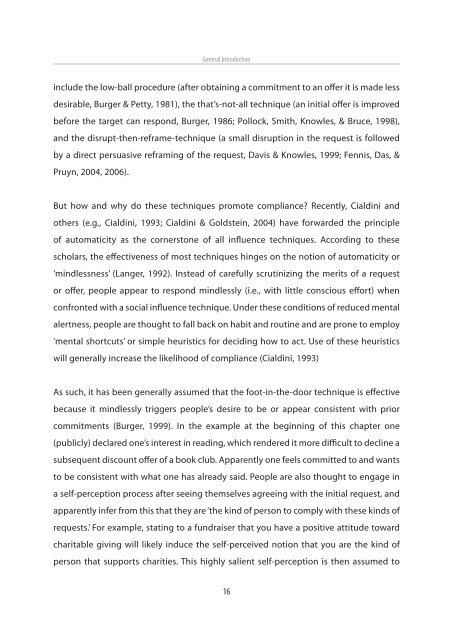Chapter 1 - Universiteit Twente
Chapter 1 - Universiteit Twente
Chapter 1 - Universiteit Twente
Create successful ePaper yourself
Turn your PDF publications into a flip-book with our unique Google optimized e-Paper software.
General Introduction<br />
include the low-ball procedure (after obtaining a commitment to an offer it is made less<br />
desirable, Burger & Petty, 1981), the that’s-not-all technique (an initial offer is improved<br />
before the target can respond, Burger, 1986; Pollock, Smith, Knowles, & Bruce, 1998),<br />
and the disrupt-then-reframe-technique (a small disruption in the request is followed<br />
by a direct persuasive reframing of the request, Davis & Knowles, 1999; Fennis, Das, &<br />
Pruyn, 2004, 2006).<br />
But how and why do these techniques promote compliance? Recently, Cialdini and<br />
others (e.g., Cialdini, 1993; Cialdini & Goldstein, 2004) have forwarded the principle<br />
of automaticity as the cornerstone of all influence techniques. According to these<br />
scholars, the effectiveness of most techniques hinges on the notion of automaticity or<br />
‘mindlessness’ (Langer, 1992). Instead of carefully scrutinizing the merits of a request<br />
or offer, people appear to respond mindlessly (i.e., with little conscious effort) when<br />
confronted with a social influence technique. Under these conditions of reduced mental<br />
alertness, people are thought to fall back on habit and routine and are prone to employ<br />
‘mental shortcuts’ or simple heuristics for deciding how to act. Use of these heuristics<br />
will generally increase the likelihood of compliance (Cialdini, 1993)<br />
As such, it has been generally assumed that the foot-in-the-door technique is effective<br />
because it mindlessly triggers people’s desire to be or appear consistent with prior<br />
commitments (Burger, 1999). In the example at the beginning of this chapter one<br />
(publicly) declared one’s interest in reading, which rendered it more difficult to decline a<br />
subsequent discount offer of a book club. Apparently one feels committed to and wants<br />
to be consistent with what one has already said. People are also thought to engage in<br />
a self-perception process after seeing themselves agreeing with the initial request, and<br />
apparently infer from this that they are ‘the kind of person to comply with these kinds of<br />
requests.’ For example, stating to a fundraiser that you have a positive attitude toward<br />
charitable giving will likely induce the self-perceived notion that you are the kind of<br />
person that supports charities. This highly salient self-perception is then assumed to<br />
16
















